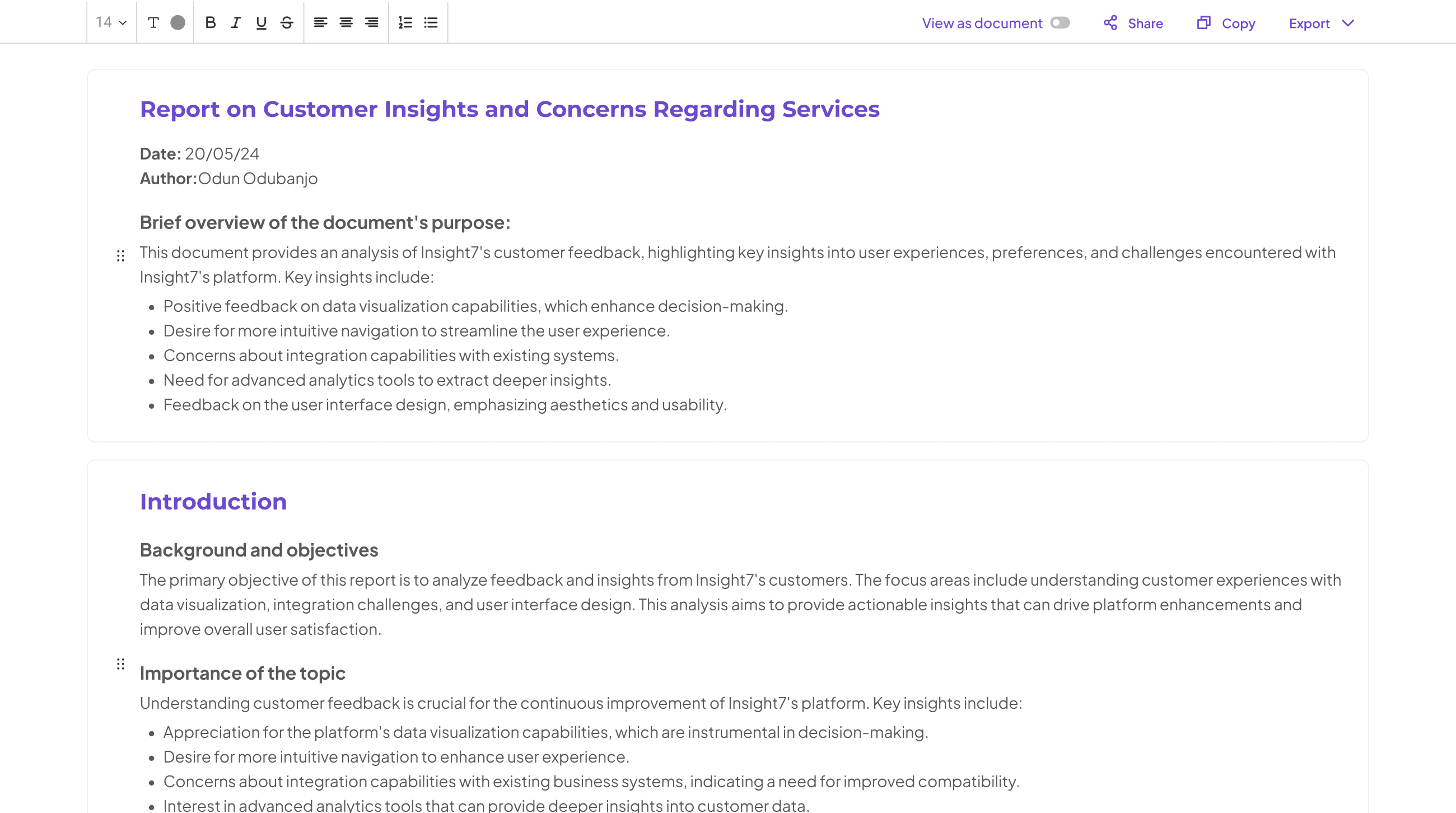How to analyze a whitepaper from customer interviews
-
Bella Williams
- 10 min read
Understanding customer interviews can significantly enhance the effectiveness of whitepapers. Whitepaper Insights Analysis allows organizations to tap into the wealth of knowledge embedded in customer feedback. By closely examining the nuances of interviews, businesses can identify key themes that resonate with their audience and inform strategic decisions.
This analysis forms a foundation for constructing whitepapers that address core concerns and interests of customers. Engaging with the insights derived from these interviews equips teams to craft compelling narratives that align with customer needs. Ultimately, the ability to distill complex information into actionable findings elevates the impact of whitepapers within any organization.
Transcribe & extract insights from interviews. At Scale.

Extracting Key Themes for Whitepaper Insights Analysis
In the process of extracting key themes for Whitepaper Insights Analysis, the first step involves identifying recurrent patterns in customer interview responses. By meticulously analyzing the transcripts from these conversations, one can pinpoint consistent topics or concerns raised by participants. This pattern recognition is crucial for consolidating insights, as it offers a clearer picture of the overarching themes that are significant to your audience.
Once the themes have been identified, categorizing the feedback is essential for turning insights into actionable recommendations. Grouping similar responses helps clarify priorities, making it easier to address major pain points or desires shared among customers. These categorized insights can lead to more informed decisions regarding whitepaper content, ultimately enhancing its relevance and impact. By applying these methods, you can ensure that your whitepaper reflects genuine customer sentiments and addresses their specific needs effectively.
Identifying Recurrent Patterns in Interview Responses
Identifying recurrent patterns in interview responses is essential for gleaning actionable insights from customer interviews. When conducting a Whitepaper Insights Analysis, the first step involves reviewing the transcripts to highlight recurring themes or sentiments. This process often unveils common pain points and expectations shared by multiple respondents, which can significantly impact the content and direction of the whitepaper.
To effectively identify these patterns, consider segmenting the interviews into manageable groups based on themes or topics. Look for phrases or issues that frequently arise, as well as the intensity and frequency of these mentions. This qualitative approach not only enriches the understanding of customer needs but also ensures that the whitepaper addresses the most pertinent topics for your audience. By synthesizing these insights, the final document will resonate more deeply with readers, guiding future strategies and improving overall engagement.
Categorizing Feedback for Actionable Insights
In analyzing feedback gathered from customer interviews, categorizing this information is essential for deriving actionable insights. Each piece of feedback can be placed into distinct categories that help identify patterns and themes. This organization allows teams to better understand the strengths and weaknesses highlighted by customers, driving meaningful improvements. When conducting a whitepaper insights analysis, categorizing feedback ensures that no crucial details slip through the cracks.
Key categories to consider include positive feedback, areas for improvement, and unique suggestions. Positive feedback can guide your emphasis on what works well, while areas for improvement direct attention to aspects that may require changes. Unique suggestions may reveal innovative ideas or perspectives that challenge the status quo. By systematically organizing feedback in this manner, you transform raw insights into a strategic resource for informed decision-making and impactful enhancements within the whitepaper.
Generate Detailed Reports from Your Qualitative Data in Minutes.
Implementation of Findings for Enhanced Whitepaper Insights Analysis
Implementing the findings from customer interviews is essential for a comprehensive whitepaper insights analysis. By strategically mapping the interview data to the various elements of your whitepaper, you can create a more engaging and informative document. This approach allows you to clearly highlight customer pain points and desires, transforming qualitative feedback into actionable insights that resonate with your intended audience.
Additionally, employing advanced analysis tools can streamline this process. These tools can efficiently aggregate and analyze data from multiple customer interactions, yielding deeper insights. You can visualize trends, summarize key themes, and derive customer-centered conclusions that significantly enhance your whitepaper's effectiveness. Incorporating these strategies will not only strengthen the validity of your insights but also contribute to a more compelling narrative in your whitepaper.
Mapping Interview Data to Whitepaper Elements
Mapping interview data to whitepaper elements is an essential step in synthesizing insights from customer discussions. By transforming qualitative interviews into concrete findings, you create a robust foundation for your whitepaper. Start by organizing the data based on common themes and recurring patterns. Group insights by specific topics or challenges that surfaced during interviews. This approach will clarify how customer input relates to the elements of your whitepaper, enhancing the overall narrative.
Next, identify key elements of your whitepaper that correspond to the insights gathered. For instance, if a significant pain point highlights the need for better resource allocation, ensure this is clearly addressed in your document. Use summaries and quotes to illustrate customer perspectives, reinforcing the relevance of your findings. By directly mapping interview data to individual sections, you ensure that your whitepaper not only reflects customer voices but also offers actionable insights that resonate with the audience.
Using Advanced Tools for Efficient Analysis
In today’s data-driven environment, using advanced tools can significantly streamline the whitepaper insights analysis. These tools allow teams to effortlessly collate and analyze data from customer interviews. By integrating user-friendly platforms, even non-experts in data analysis can harness insights from complex transcripts efficiently. This democratization of data access enables all team members to engage in the analysis process, fostering a collaborative approach.
Moreover, these tools employ sophisticated algorithms to identify patterns, themes, and customer sentiments within large datasets. Features like automated transcription and intelligent extraction of key points transform raw interview data into actionable insights. By summarizing customer experiences and pinpointing pain points, organizations can directly address challenges and enhance their products or services. Ultimately, these advanced analytical solutions not only streamline the workflow but also empower businesses to make informed decisions based on refined customer feedback.
Conclusion: The Future of Whitepaper Insights Analysis and Customer Feedback
As we look ahead, the future of whitepaper insights analysis and customer feedback is promising and transformative. The ability to convert customer interviews into actionable insights is becoming more refined, enabling businesses to extract invaluable data from conversations. This democratization of analysis empowers team members at all levels to contribute meaningfully to the whitepaper development process, culminating in a more comprehensive understanding of customer needs.
Moreover, advancements in technology pave the way for faster and more accurate data interpretation. This evolution stands to enhance the quality of whitepapers significantly, making them tailored to the preferences and feedback of the target audience. Overall, the integration of customer insights into whitepapers will not only foster stronger relationships with clients but also drive innovation and adaptability in business strategies.







